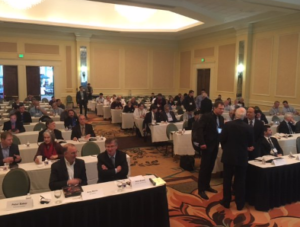Considered by many to be one of the biggest manufacturing revolutions of this century, 3D printing has captivated and intrigued individuals in a wide spectrum of fields and industries. From the independent crafter to the leadership behind some of the biggest companies in the world, to some of the most prestigious universities, it is safe to say that the future is 3D printed.
The Laser Additive Manufacturing Workshop (LAM) last month helped emphasize that point, with some of the most-talked-about presentations revolving around 3D printing innovations.
Five 3D Printing Innovations You May Have Missed at LAM 2017
1. GE Plans to Go Full Vertical by 2022, Plans Parallel Supply Chain
It is no secret that GE is investing ample time, resources, and funding into its additive manufacturing

initiatives. The company has created additive manufacturing applications across multiple GE businesses and has earned over 300 patents in powder metals used in the additive process.
During the Accelerating the Additive Revolution keynote on Day one of LAM®, GE Additive’s Greg Morris revealed that the company plans to become fully vertical by 2022. Concerning the supply chain, Morris does not believe that the current methods will be replaced immediately. Instead, both traditional and additive manufacturing methods will exist side by side. The company is continuing its focus on being a user and developer of additive manufacturing capabilities, as demonstrated by the willingness to integrate the technology alongside existing practices.
2. OPTOMEC Debuts New LENS Machines- Making Additive Manufacturing Affordable
A challenge for many industries looking to join the 3D printing revolution is the anticipated cost of equipment. At LAM, OPTOMEC debuted a potential solution to this issue with their new LENS machines. The three new LENS systems use lasers ranging from 500W to 4kW to create 3D structures. Prices start at under $25,000; a price point that puts 3D printing capabilities into the hands of more people.
The systems are designed to help reduce the process time and cost while increasing the quality and capability for design changes- or in simpler terms, all the qualities that entice industries to explore additive manufacturing in the first place. The new systems join the existing line of LENS machines and will fill gaps in demand for low-cost additive systems, thus making the 3D revolution more accessible and affordable than ever.
3. Stryker Discusses the Future of Custom Printed Implants
“We can design anything,” Marc Esformes of Stryker, told the audience at LAM®. Stryker’s additive  manufacturing efforts are revolutionizing the future for medical implants, through their focus on 3D printing to develop innovative medical devices.
manufacturing efforts are revolutionizing the future for medical implants, through their focus on 3D printing to develop innovative medical devices.
Esformes discussed the potential for custom, 3D printed implants that would take a matter of weeks from 3D scan to 3D printed part. The 3D printing process allows for a more biocompatible implant, reducing the chance of rejection and infection in patients, a point of great interest for the future of Stryker’s medical additive manufacturing applications.
4. Fraunhofer Discusses Low-Cost SLM Systems
Fraunhofer Institute for Laser Technology (ILT) lead two presentations at LAM® 2017. One of which discussed selective laser melting, an additive manufacturing process that is potentially an economical choice for 3D printing of parts.
The cost of production using SLM Systems relates less to the complexity of the part, and more about the physical volume. The systems allow for individualization, as details can be altered before the part begins production. Should the SLM process be utilized from concept to completion, the utilization could be game changing for parts manufacturing.
5. Siemens Aiming to Reduce Production Time, Using More AM Machinery, With Less Risk
Siemens has made significant waves with their adoption of additive manufacturing processes. At LAM, Ingomar Kelbessa discussed the company’s approach and plans toward increased 3D printing adoption.
In a just under two years, Siemens was able to develop an entire process chain to optimize their gas turbine blades. The system lead to a 90% reduction in lead time, through the use of 24 additive manufacturing machines. Siemens hopes that this reduced time and increased flexibility with the manufacturing of parts can lead to greater customer satisfaction and parts-on-demand.
—
Want to keep with the latest in 3D printing, additive manufacturing, and all things lasers? Sign up for Lasers Today and have the latest in industry news, developments, and updates delivered straight to your inbox!
The Laser Institute of America (LIA) is the international society for laser applications and safety. Our mission is to foster lasers, laser applications, and laser safety worldwide. To learn more about LAM 2017 and the LAM Workshop by LIA, visit the official workshop website.





